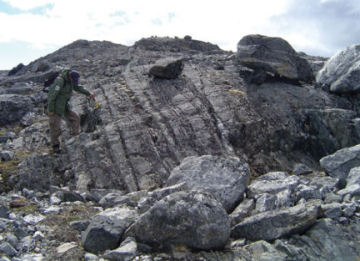Earth Rocks On
Some rocks in Greenland show that Earth's crust was moving even 3.8 billion years ago.
By Emily Sohn
Most of the time, the ground feels solid beneath our feet.
That’s comforting. But it’s also misleading because there’s actually a lot going on underground. Masses of land (called plates) slip, slide, and bump against each other, slowly changing the shape of continents and oceans over millions and billions of years.
 |
|
Layers of volcanic rock within this 3.8-billion-year-old piece of crust reveal that plate tectonics started early in Earth’s history. |
| Science |
Scientists know that Earth formed about 4.5 billion years ago. They also know that our planet was hot at first. As it cooled, its outermost layer, called the crust, eventually formed moving plates. Exactly when this shift happened, however, is an open question.
Now, an international group of researchers has an answer. They’ve found new evidence suggesting that Earth’s crust started shifting at least 3.8 billion years ago. The new estimate is 1.3 billion years earlier than previous ones.
Not long before 3.8 billion years ago, lots of asteroids were pummeling Earth, keeping its crust in a hot, molten state. After the hard crust formed, much of it sank at various times into the planet’s hot insides. There, it melted before returning to the surface as lava.
In some places, however, the crust never sank.
One of the oldest such places is in Greenland, in an area called the Isua supracrustal belt. The rocky crust there is between 3.7 and 3.8 billion years old. The belt was once part of the seafloor, but now it is exposed to air.
The researchers recently took a close look at the Isua supracrustal belt. They noticed long, parallel cracks in the rock that have been filled in with a type of volcanic rock.
To explain this structure, the scientists propose that tension in the crust caused the seafloor to crack open long ago. Hot, liquid rock, called magma, oozed up from deep inside Earth to fill the cracks. Finally, the whole area cooled, forming what we see today.
That explanation, plus chemical clues inside the rock, suggests that the Isua supracrustal belt was once part of a plate under the ocean, beginning around 3.8 billion years ago.
“It’s a marvelous case of solving a jigsaw puzzle,” says one of the researchers, Gustaf Arrhenius of the Scripps Institution of Oceanography in La Jolla, Calif. He notes that the puzzle was “a very difficult one because these rocks are all very old and have been badly mangled.”—E. Sohn
Going Deeper:
Barry, Patrick. 2007. Young and restless: Ancient Earth shows moving crust. Science News 171(March 24):179. Available at http://www.sciencenews.org/articles/20070324/fob1.asp .
Ramsayer, Kate. 2004. Deep drilling at sea. Science News for Kids (Sept. 8). Available at http://www.sciencenewsforkids.org/articles/20040908/Feature1.asp .
Sohn, Emily. 2004. Hints of life in ancient lava. Science News for Kids (April 28). Available at http://www.sciencenewsforkids.org/articles/20040428/Note2.asp .







